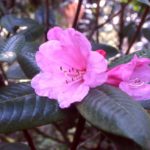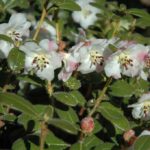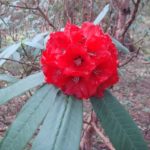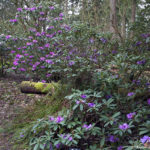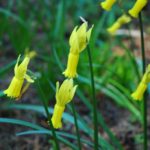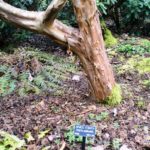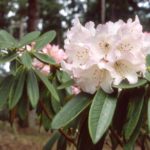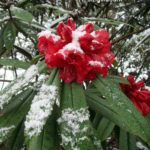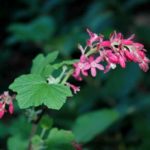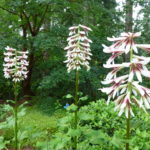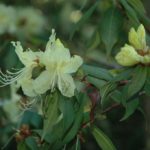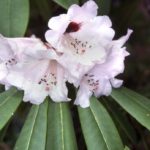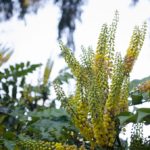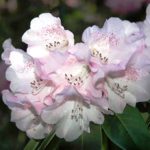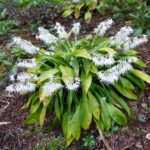- R. hirtipes 73-136
- R. leucaspis
- R. barbatum 65-403
- R ririei
- R. degronianum ssp. yakushimanum
- Narcissus cyclaminues
- Stewartia pseudocamellia
- R. principis 65/282
- Ribes sanguineum
- Cardiocrinum giganteum
- R. lutescens Bagshot Sands
- Fern Stumpery
- R. praevernum 66/563
- Mahonia
- R. oreodoxa var fargesii
- Ypsilandra thibetica
#1 Rhododendron strigillosum welcomes you to the garden as you enter to the courtyard. This early flowering species puts on a spectacular display every year. It has distinctive bristles on the midrib, petiole, and foliage. R. strigillosum is native to Sichuan and NE Yunnan, China.
Turn left on the main road and continue to the path on the left. This area is called the Upper Woodland Garden which features many species with thickly indumented leaf undersurfaces. On your left, #2 Ribes sanguineum (Flowering Currant) is in bloom. Native to the North-west, this plant adds great color to the woodland garden in late winter when not many things are in bloom. This pure white selection is called ‘Henry Henneman.’
Keep going downhill and stay on the right path as it veers to the right. Go across the main road to visit #3 Rhododendron praevernum. This quite showy and very hardy species is native to W. Hubei and E. Sichuan, China.
Go back to the main road and go down the hill. Right after you pass the bamboo on your right, you will see #4 Rhododendron oreodoxa v. fargesii. This is an easily grown and free flowering species with very frost hardy flower buds. That is why they bloom reliably every year despite the early season bloom. It is native to woodlands in Sichuan, Gansu, and Hubei in China.
Now take the next marked left turn to visit the Big-Leaf Garden. Most of the big-leafed rhododendrons eventually become very large trees in their native temperate rain-forests in the Sino-Himalaya. Many of these rhododendrons bloom fairly early in season including R. rothschildii and R. praestans.
Follow the sign for the self-guided tour and continue forward to #5 Rhododendron principis in bloom on your right. This is a very attractive species with thick and spongy white indumentum on the underside of the leaves. It is found only in E. Tibet where it is common in a wide variety of habitats.
At this point, take a sharp right back toward the main path. On your right you will notice a large planting of clumping evergreen perennial plants in full flower #6. This is a lily relative from China known as #6 Ypsilandra thibetica and the white flowers are very fragrant. This easily grown woodland wildflower was introduced into cultivation by the RSBG.
Now, go back to the main road and take a left. Walk past the black bamboo on your left and a large flowering Mahonia (#7) on your right. The bright yellow flowers of this plant are a valuable food source for over-wintering hummingbirds.
Just past this point is the Meconopsis meadow planted with hundreds of Himalayan Blue Poppies*. Check out the new growth of Cardiocrinum giganteum (#8) which looks similar to a shiny giant green hosta. This is the Himalayan Giant Lily which can grow to 12 feet tall with masses of six inch long fragrant flowers in June. Narcissus cyclamineus (#9) was added to this meadow within last few-years. These bright yellow pendant flowers with sharply reflexed petals are very attractive. They thrive in damp conditions. The clusters of emerging fuzzy leaves are the Blue Poppies, make sure you come back to see them blooming in late April and May, it’s spectacular. Behind the Meconopsis Meadow, Rhododendron erosum (#10) is putting on quite a show. This species is very closely related to #11 Rhododendron barbatum which is planted on the right side of the Meconopsis Meadow. Both species have very attractive smooth peeling bark and are native to the high mountain forests of the Himalayas.
Keep going along the main path until you see the Hardy Fern Foundation’s Stumpery (#12) on your right. A stumpery is a Victorian period garden design that romanticizes nature. The design uses tree roots, placed on their sides or upside down. The tree roots are exposed creating a “Wild Scene” and then planted with thousands of ferns and other woodland plants. As you enter the stumpery, you will note a grove of red-flowering Rhododendron strigillosum (#13) on your right. Have a seat on the cut cedar-log bench at the top of the stumpery and enjoy the view of the pond garden. Behind that log, #14 Rhododendron hirtipes is in bloom. This rarely encountered species has vibrant, “hot pink” flowers that are very attractive in early spring. This plant is native to SE Tibet.
From the stumpery, take the path to the pond garden (follow the sign). #15 Rhododendron lanigerum is putting on a spectacular show this year and is from Tibet and India. Take a right turn to visit #16 Rhododendron ririei. The bell-shaped flowers are purplish in color with dark nectar pouches and the lower surface of the leaves are covered with a thin plastered indumentum. It is native to a limited area of Sichuan, China.
Proceed around the curve and keep going straight. Follow the signs across the road until you reach #17 Rhododendron leucaspis with its flat white flowers and chocolate anthers. The leaves are densely covered with soft hairs. This plant is native to SE Tibet. Right after that, you will see #18 Rhododendron lutescens on your right. This lovely species with pale yellow flowers also has attractive reddish new growth.
Take the first right and walk toward the gazebo which is surrounded by #19 Rhododendron degronianum ssp. yakushimanum*. Come back in early May to see the impressive floral display of this species. Follow the signs for the self-guided tour which will take you past #20 Stewartia pseudocamellia, a summer-flowering tree with beautiful bark. This camellia relative also has colorful fall foliage.
Continue straight ahead to the Rutherford Conservatory. (A separate self-guided handout is available to tour the Rutherford Conservatory)
From here, you can walk back to the Garden Shop where you started. Many of the plants you viewed today are available in the RSBG Nursery. Most of these plants are rare and hard to find in retail nurseries. We hope you enjoyed the self guided tour today. Please come back and visit the garden soon.


